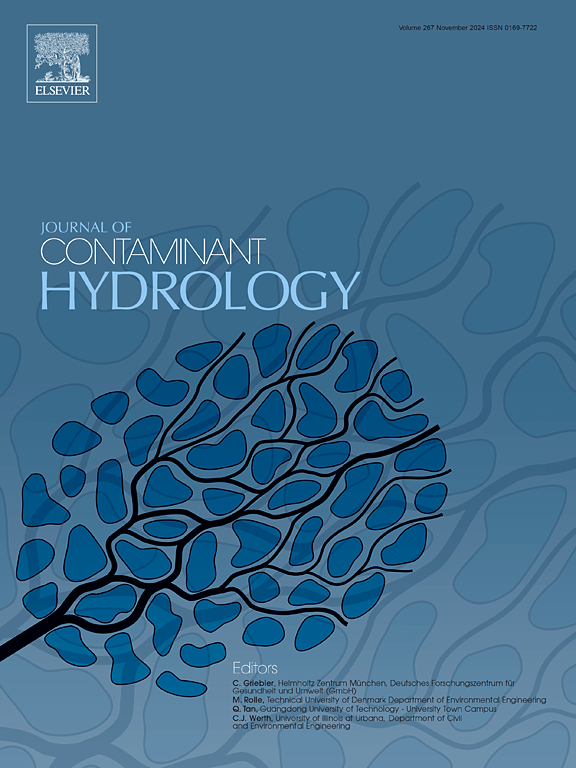Effectiveness of double-cut-off walls on seawater intrusion and nitrate concentration in unconfined coastal aquifers
IF 3.5
3区 环境科学与生态学
Q2 ENVIRONMENTAL SCIENCES
引用次数: 0
Abstract
An effective coastal engineering technique for preventing seawater intrusion is constructing a cut-off wall. Nevertheless, the cut-off walls impact on nitrate concentration in downstream aquifers has not been assessed in the previous research that focused on studying a single subsurface physical barrier. In this work, a numerical model was used to examine the effect and mechanisms of the double-cut-off walls on saltwater wedge length and nitrate concentrations transported downstream of them. SEAWAT code has been implemented to simulate seawater intrusion and nitrate transport in unconfined coastal aquifers. Two cases of homogeneous aquifer (Case-H) and heterogeneous aquifer (Case-LH) were studied. The results showed significantly receded in the saltwater wedge and the spread of nitrate contamination increased due to the heterogeneous conditions. A significant effect on nitrate accumulation and an increase in the pollution area between the double-cut-off walls was observed when the second cut-off wall depth was embedded by more than 50 % of the aquifer thickness due to the weak inflow below the cut-off wall. There was no need to raise the second cut-off depth because there was a significant retraction in the saltwater interface after the first cut-off wall was embedded to a depth of more than 70 % of the aquifer thickness. Raising the second cut-off wall depth to more than 30 % of the aquifer thickness when the first cut-off wall depth ratio was less than 50 % significantly impacted the retreating of the saltwater wedge for the short distance between the double-cut-off walls. When the second cut-off wall depth ratio was less than 50 %, raising the first cut-off wall depth significantly lowered the total concentrations of the nitrate that arrived at the double-cut-off walls downstream. In addition, the total concentrations of the nitrate that traveled toward the sea were reduced to 17 % of the original nitrate concentration by raising the depth of both cut-off walls to 70 % of the aquifer thickness and the distance between them to more than 25 m. Although it was shown that the double-cut-off walls substantially reduced saltwater intrusion and nitrate concentrations, they also created a large dispersion area of nitrate pollution, especially in the heterogeneous aquifer. The retreat of the saltwater interface wedge was significantly impacted by the first cut-off wall depth in the heterogeneous aquifer. This study offers useful information for preventing saltwater intrusion and reducing nitrate concentration downstream of the double-cut-off walls, especially, the double-cut-off walls represent a new study for controlling saltwater intrusion and nitrate pollution in a coastal aquifer. The outcomes of this study can be used for the groundwater resources proper management in coastal aquifers.
双截流墙对沿海无约束含水层海水入侵和硝酸盐浓度的影响
防渗墙是防止海水入侵的一种有效的海岸工程技术。然而,之前的研究主要集中在研究单个地下物理屏障,并没有评估截流墙对下游含水层硝酸盐浓度的影响。本文采用数值模型研究了双截流墙对咸水楔形长度和其下游输送的硝酸盐浓度的影响及其机制。实施了SEAWAT代码来模拟海水入侵和硝酸盐在无约束沿海含水层中的运移。研究了均质含水层(Case-H)和非均质含水层(Case-LH)两种情况。结果表明,由于非均质条件的影响,咸水楔中硝酸盐污染明显消退,硝酸盐污染扩散加剧。当第二截流墙深度嵌入超过含水层厚度的50%时,由于截流墙下方的流入较弱,对双截流墙之间的硝酸盐积累和污染面积增加有显著影响。没有必要提高第二个截止深度,因为在第一个截止墙嵌入到含水层厚度的70%以上的深度后,咸水界面会出现明显的回撤。在第一截流墙深度比小于50%的情况下,将第二截流墙深度提高到含水层厚度的30%以上,由于双截流墙之间的距离较短,对咸水楔的回撤有显著影响。当第二截流墙深度比小于50%时,提高第一截流墙深度可显著降低到达双截流墙下游的硝酸盐总浓度。此外,通过将两道截流墙的深度提高到含水层厚度的70%,并将两道截流墙之间的距离提高到25 m以上,将流向海洋的硝酸盐总浓度降低到原来的17%。虽然研究表明,双截止墙大大减少了盐水入侵和硝酸盐浓度,但它们也造成了硝酸盐污染的大面积扩散,特别是在非均质含水层中。在非均质含水层中,第一截止墙深度对咸水界面楔块的后退有显著影响。该研究为防止海水入侵和降低双截流墙下游的硝酸盐浓度提供了有用的信息,特别是双截流墙为控制沿海含水层的盐水入侵和硝酸盐污染提供了新的研究方向。研究结果可为沿海含水层地下水资源的合理管理提供参考。
本文章由计算机程序翻译,如有差异,请以英文原文为准。
求助全文
约1分钟内获得全文
求助全文
来源期刊

Journal of contaminant hydrology
环境科学-地球科学综合
CiteScore
6.80
自引率
2.80%
发文量
129
审稿时长
68 days
期刊介绍:
The Journal of Contaminant Hydrology is an international journal publishing scientific articles pertaining to the contamination of subsurface water resources. Emphasis is placed on investigations of the physical, chemical, and biological processes influencing the behavior and fate of organic and inorganic contaminants in the unsaturated (vadose) and saturated (groundwater) zones, as well as at groundwater-surface water interfaces. The ecological impacts of contaminants transported both from and to aquifers are of interest. Articles on contamination of surface water only, without a link to groundwater, are out of the scope. Broad latitude is allowed in identifying contaminants of interest, and include legacy and emerging pollutants, nutrients, nanoparticles, pathogenic microorganisms (e.g., bacteria, viruses, protozoa), microplastics, and various constituents associated with energy production (e.g., methane, carbon dioxide, hydrogen sulfide).
The journal''s scope embraces a wide range of topics including: experimental investigations of contaminant sorption, diffusion, transformation, volatilization and transport in the surface and subsurface; characterization of soil and aquifer properties only as they influence contaminant behavior; development and testing of mathematical models of contaminant behaviour; innovative techniques for restoration of contaminated sites; development of new tools or techniques for monitoring the extent of soil and groundwater contamination; transformation of contaminants in the hyporheic zone; effects of contaminants traversing the hyporheic zone on surface water and groundwater ecosystems; subsurface carbon sequestration and/or turnover; and migration of fluids associated with energy production into groundwater.
 求助内容:
求助内容: 应助结果提醒方式:
应助结果提醒方式:


